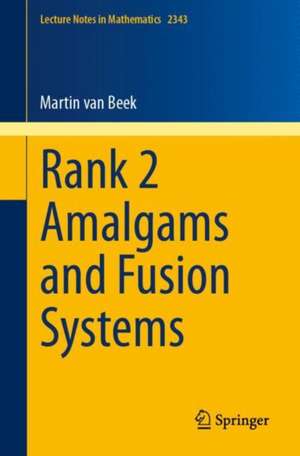Rank 2 Amalgams and Fusion Systems: Lecture Notes in Mathematics, cartea 2343
Autor Martin van Beeken Limba Engleză Paperback – 20 apr 2024
Din seria Lecture Notes in Mathematics
- 17%
 Preț: 360.42 lei
Preț: 360.42 lei -
 Preț: 459.92 lei
Preț: 459.92 lei -
 Preț: 121.41 lei
Preț: 121.41 lei -
 Preț: 175.68 lei
Preț: 175.68 lei -
 Preț: 197.00 lei
Preț: 197.00 lei -
 Preț: 279.76 lei
Preț: 279.76 lei -
 Preț: 477.65 lei
Preț: 477.65 lei - 17%
 Preț: 361.88 lei
Preț: 361.88 lei -
 Preț: 252.37 lei
Preț: 252.37 lei -
 Preț: 353.99 lei
Preț: 353.99 lei -
 Preț: 138.88 lei
Preț: 138.88 lei -
 Preț: 152.61 lei
Preț: 152.61 lei -
 Preț: 116.67 lei
Preț: 116.67 lei -
 Preț: 102.77 lei
Preț: 102.77 lei - 17%
 Preț: 365.52 lei
Preț: 365.52 lei -
 Preț: 396.75 lei
Preț: 396.75 lei - 17%
 Preț: 362.12 lei
Preț: 362.12 lei -
 Preț: 396.11 lei
Preț: 396.11 lei -
 Preț: 357.78 lei
Preț: 357.78 lei - 17%
 Preț: 362.31 lei
Preț: 362.31 lei -
 Preț: 403.80 lei
Preț: 403.80 lei - 17%
 Preț: 361.70 lei
Preț: 361.70 lei -
 Preț: 499.87 lei
Preț: 499.87 lei -
 Preț: 457.03 lei
Preț: 457.03 lei -
 Preț: 395.90 lei
Preț: 395.90 lei -
 Preț: 459.00 lei
Preț: 459.00 lei -
 Preț: 487.57 lei
Preț: 487.57 lei -
 Preț: 424.01 lei
Preț: 424.01 lei -
 Preț: 487.57 lei
Preț: 487.57 lei -
 Preț: 330.55 lei
Preț: 330.55 lei -
 Preț: 325.75 lei
Preț: 325.75 lei -
 Preț: 350.30 lei
Preț: 350.30 lei -
 Preț: 331.31 lei
Preț: 331.31 lei -
 Preț: 408.37 lei
Preț: 408.37 lei -
 Preț: 328.25 lei
Preț: 328.25 lei -
 Preț: 421.28 lei
Preț: 421.28 lei -
 Preț: 276.08 lei
Preț: 276.08 lei -
 Preț: 424.60 lei
Preț: 424.60 lei -
 Preț: 422.05 lei
Preț: 422.05 lei -
 Preț: 505.01 lei
Preț: 505.01 lei -
 Preț: 422.05 lei
Preț: 422.05 lei -
 Preț: 274.93 lei
Preț: 274.93 lei -
 Preț: 335.16 lei
Preț: 335.16 lei -
 Preț: 422.27 lei
Preț: 422.27 lei -
 Preț: 497.49 lei
Preț: 497.49 lei -
 Preț: 272.81 lei
Preț: 272.81 lei -
 Preț: 428.04 lei
Preț: 428.04 lei -
 Preț: 376.22 lei
Preț: 376.22 lei -
 Preț: 427.10 lei
Preț: 427.10 lei -
 Preț: 325.92 lei
Preț: 325.92 lei
Preț: 449.90 lei
Nou
Puncte Express: 675
Preț estimativ în valută:
86.10€ • 88.95$ • 71.66£
86.10€ • 88.95$ • 71.66£
Carte tipărită la comandă
Livrare economică 25 martie-08 aprilie
Preluare comenzi: 021 569.72.76
Specificații
ISBN-13: 9783031544606
ISBN-10: 3031544609
Ilustrații: VII, 206 p. 2 illus.
Dimensiuni: 155 x 235 mm
Greutate: 0.31 kg
Ediția:2024
Editura: Springer Nature Switzerland
Colecția Springer
Seria Lecture Notes in Mathematics
Locul publicării:Cham, Switzerland
ISBN-10: 3031544609
Ilustrații: VII, 206 p. 2 illus.
Dimensiuni: 155 x 235 mm
Greutate: 0.31 kg
Ediția:2024
Editura: Springer Nature Switzerland
Colecția Springer
Seria Lecture Notes in Mathematics
Locul publicării:Cham, Switzerland
Cuprins
Introduction.- Preliminaries.- Fusion Systems.- Amalgams in Fusion Systems.- The Amalgam Method.- Zα′ ̸≤ Qα.- Zα′ ≤ Qα.
Notă biografică
Martin van Beek is a Heilbronn Research Fellow at the University of Manchester. His main research interest is finite group theory and its interactions with other areas of mathematics, such as algebraic topology and representation theory. He is fascinated by the study of p-local structure in finite groups, and how to use this data to garner useful global information. Previously, he was a postdoctoral researcher at the University of Birmingham, where he also completed his PhD.
Textul de pe ultima copertă
This monograph provides a comprehensive treatment of the classification of small fusion systems, that is, fusion systems with few essential subgroups. It demonstrates a broad range of techniques from local group theory and fusion systems, several of which can be applied in more general settings. Addressing research problems that have not been treated in the past, it is the first text to explicitly use the amalgam method in this context.
Fusion systems offer an enticing way to unify various p-local methods employed in group theory, representation theory and homotopy theory; but as abstract constructions they are still somewhat mysterious. This book paves the way to a broad and systematic study of these categories by applying the amalgam method, thus modernizing a methodology widely used to understand the local structure of finite groups. With this comes an introduction to several vital techniques in local group theory, a generous survey of the structure and modular representation theory of some important families of finite groups, and a demonstration of the value of combinatorial methods in finite group theory and fusion systems.
Primarily aimed at researchers active in fusion systems and group amalgams, the book will also be of interest to anyone working with finite groups and their modular representations, group actions on trees, or classifying spaces. The inclusion of preliminary chapters outlining the theoretical prerequisites make it ideal for a short lecture course or as a reading group text for early career researchers and graduate students.
Caracteristici
Classifies small fusion systems and provides generic methods for treating larger classes of fusion systems Gives a modern exposition of the amalgam method and its use in understanding finite groups and fusion systems Provides detailed structural information and identification results for certain small finite simple groups
